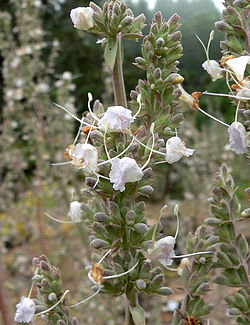|
Salvia plant, white sage, salvia apiana
Introduction[Top]
This page is about the salvia plant known as salvia apiana. It is also known as white sage, sacred sage and bee sage. It belongs to the salvia genus which also includes common sage and salvia divinorum. It is native to northwestern Mexico and southwestern United States. It is mainly found in the western areas of the Sonoran and Mojave deserts of Baja California and the coastal sage scrub areas of Southern California.
What white sage is used for[Top] Native Americans used white in sweat lodges and for a variety of ailments such as
How white sage is used[Top] White sage is available in the form of smudge sticks, incense, essential oil and liquid extract.
Science says[Top] White sage contains eucalyptol, eucalyptol is found in many brands of cough suppressant and mouth wash. Researchers from Germany conducted a study involving 152 patients with sinusitis. The research found that subjects treated with eucalyptol had less frontal headache, headache on bending, sensitivity of pressure points of trigeminal nerve, rhinological secretion and nasal obstruction. In a study carried out by researchers from the Faculty of Bioresources, Mie University, Japan, eucalyptol killed leukemia cells in vitro. View link
Side effects and cautions[Top] Salvia apiana is thought to be safe with known side effects.
Return to natural healing home page
|
Loading



